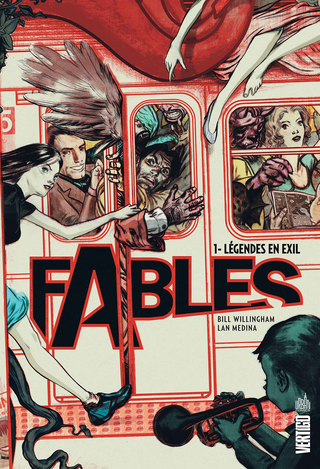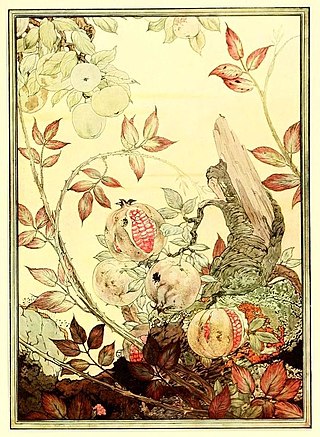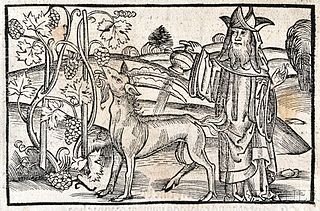Related Research Articles

The Panchatantra is an ancient Indian collection of interrelated animal fables in Sanskrit verse and prose, arranged within a frame story. The surviving work is dated to about 300 CE, but the fables are likely much more ancient. The text's author is unknown, but it has been attributed to Vishnu Sharma in some recensions and Vasubhaga in others, both of which may be fictitious pen names. It is likely a Hindu text, and based on older oral traditions with "animal fables that are as old as we are able to imagine".

Aesop's Fables, or the Aesopica, is a collection of fables credited to Aesop, a slave and storyteller who lived in ancient Greece between 620 and 564 BCE. Of varied and unclear origins, the stories associated with his name have descended to modern times through a number of sources and continue to be reinterpreted in different verbal registers and in popular as well as artistic media.

The Boy Who Cried Wolf is one of Aesop's Fables, numbered 210 in the Perry Index. From it is derived the English idiom "to cry wolf", defined as "to give a false alarm" in Brewer's Dictionary of Phrase and Fable and glossed by the Oxford English Dictionary as meaning to make false claims, with the result that subsequent true claims are disbelieved.

Fables is an American comic book series created and written by Bill Willingham, published by DC Comics' Vertigo imprint. Willingham served as sole writer for its entirety, with Mark Buckingham penciling more than 110 issues. The series featured various other pencillers over the years, most notably Lan Medina and Steve Leialoha. Fables was launched in July 2002 and concluded in July 2015. It was revived in 2022 with a 12-issue continuation to the main series, as well as a 6-issue spin-off miniseries Batman vs. Bigby! A Wolf in Gotham, both published under DC Black Label.
A wolf in sheep's clothing is an idiom from Jesus's Sermon on the Mount as narrated in the Gospel of Matthew. It warns against individuals who play a duplicitous role. The gospel regards such individuals as dangerous.

The Farmer and the Viper is one of Aesop's Fables, numbered 176 in the Perry Index. It has the moral that kindness to evil will be met by betrayal and is the source of the idiom "to nourish a viper in one's bosom". The fable is not to be confused with The Snake and the Farmer, which looks back to a situation when friendship was possible between the two.

Pandora's box is an artefact in Greek mythology connected with the myth of Pandora in Hesiod's c. 700 B.C. poem Works and Days. Hesiod related that curiosity led her to open a container left in the care of her husband, thus releasing curses upon mankind. Later depictions of the story have been varied, with some literary and artistic treatments focusing more on the contents than on Pandora herself.

The Wolf and the Crane is a fable attributed to Aesop that has several eastern analogues. Similar stories have a lion instead of a wolf, and a stork, heron or partridge takes the place of the crane.

The Wolf and the Lamb is a well-known fable of Aesop and is numbered 155 in the Perry Index. There are several variant stories of tyrannical injustice in which a victim is falsely accused and killed despite a reasonable defence.

The Story of Aḥiqar, also known as the Words of Aḥiqar, is a story first attested to in Imperial Aramaic from the fifth century BCE on papyri from Elephantine, Egypt, that circulated widely in the Middle and the Near East. It has been characterised as "one of the earliest 'international books' of world literature".

The Trees and the Bramble is a composite title which covers a number of fables of similar tendency, ultimately deriving from a Western Asian literary tradition of debate poems between two contenders. Other related plant fables include The Oak and the Reed and The Fir and the Bramble.

Speaking of The Snake and the Crab in Ancient Greece was the equivalent of the modern idiom, 'Pot calling the kettle black'. A fable attributed to Aesop was eventually created about the two creatures and later still yet another fable concerning a crab and its offspring was developed to make the same point.
The Crow or Raven and the Snake or Serpent is one of Aesop's Fables and numbered 128 in the Perry Index. Alternative Greek versions exist and two of these were adopted during the European Renaissance. The fable is not to be confused with the story of this title in the Panchatantra, which is completely different.
The Priest and the Wolf is an ancient fable of West Asian origin that was included in collections of Aesop's Fables in mediaeval Europe. It illustrates how even education cannot change one's basic nature and tells how a priest tries to teach a wolf to read.
The title of The Woodcutter and the Trees covers a complex of fables that are of West Asian and Greek origins, the latter ascribed to Aesop. All of them concern the need to be wary of harming oneself through misplaced generosity.

The Goat and the Vine is counted as one of Aesop's Fables and is numbered 374 in the Perry Index. There is also a West Asian variant.

The Dog and the Wolf is one of Aesop's Fables, numbered 346 in the Perry Index. It has been popular since antiquity as an object lesson of how freedom should not be exchanged for comfort or financial gain. An alternative fable with the same moral concerning different animals is less well known.
The Fowler and the Snake is a story of Greek origin that demonstrates the fate of predators. It was counted as one of Aesop's Fables and is numbered 115 in the Perry Index.
References
- ↑ Aesopica site
- ↑ The Story of Ahikar, Cambridge 1889, p. 54